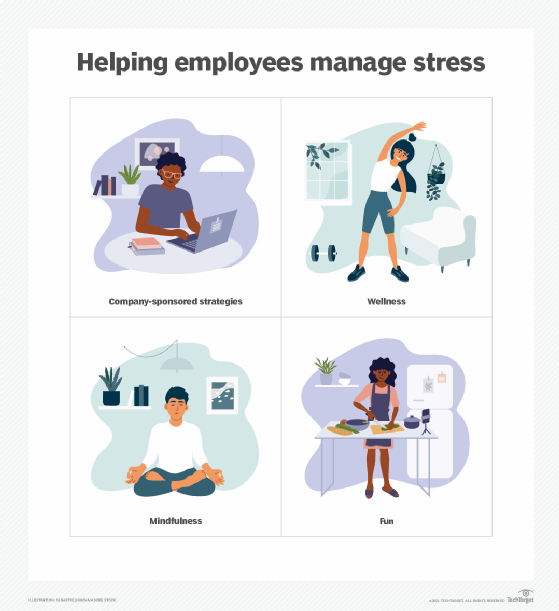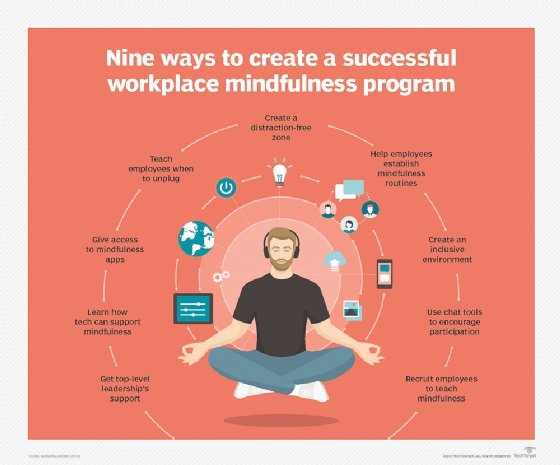
denphumi - Fotolia
30 easy ways to help employees manage stress
Companies can go beyond wellness programs with these strategies, which range from easy ideas to more long-term solutions for helping employees manage stress.
Employees have been overwhelmed with stress in recent years and the pandemic exacerbated that stress exponentially.
Many workplaces have wellness programs, and those programs can lead to positive effects. However, smaller-scale strategies can also help employees manage stress. These range from easy initiatives to slightly more involved but still easy-to-tackle possibilities.
Here are 30 ideas that HR leaders and managers can consider.
Company-sponsored strategies
When de-stressing ideas come directly from the company, employees see the company cares about their wellbeing. Here are some ideas for how higher-ups can help workers lower their stress levels.
Financial management class. Financial wellness programs are sometimes already part of wellness initiatives, but if not, HR can start on a smaller scale with a financial management class. Employees who feel in control of their finances are likely less stressed, and a refresher on finance basics could benefit many.
Flexible work hours. For some employees, keeping to a rigid schedule is stressful, especially if they're balancing other responsibilities at home. A company can ease this stress by being adaptable and allowing employees to work a flexible schedule.
Set hours for email correspondence. Employees need to feel there are times when they're not on call. Organizations can implement and then follow a rule about not sending emails or other messages after certain hours. Higher-ups' examples are crucial.

Employee home office budget. If employees spend most of their time sitting down, ergonomics are critical. Even after more than a year of many Americans working from home, some workers may still be setting up shop at a kitchen table or in an uncomfortable chair. Giving employees a home office budget can reduce stress because employees can improve their setup and get equipment that helps them stay physically healthy and injury-free.
Discounts for meal prep services. Some employees may currently find searching for recipes and going grocery shopping to be overwhelming tasks. Employee discounts for meal prep services can give them an option to offload some of their duties.
Training on time management. Employees may be stressed because they don't know to balance all the tasks in their day. A time management class can teach workers best practices for their workday so they aren't as likely to get frazzled.
Wellness
Healthy employees are likely to be happier and calmer. Small strategies can make employees feel better and are easy to integrate into the workday.
Walking meetings. During COVID-19, video meetings can be crucial for maintaining connection, but not every meeting needs to be on video. Employees could have a phone meeting as they stroll around their neighborhood.
Lunch break posts. Office-based workers need a lunch hour when they can recharge, and eating a sandwich in front of a laptop shouldn't count. HR can encourage employees to take their full lunch break, then ask them to post on Slack or Teams about how they spent their time. For example, employees can post that they took a dog for a walk, played board games with a child or participated in an exercise class.
Screen breaks. Employees are more likely to feel stressed if their eyes are smarting at the end of the day. HR should educate workers about the importance of screen breaks and encourage setting timers for 20 minute intervals. Once the timer dings, workers should look at a distant object for 20 seconds.
Reimbursement of blue-light-blocking glasses. Glasses for blocking blue-light can help workers combat the effects of staring at a laptop all day. Companies can offer discounts or full reimbursements.
Employee stress balls. Wrist strain at the end of a long day of typing is a persistent danger for office workers. Companies can send workers stress balls along with a handout (sent virtually to save paper) about suggested stretches and how often to do them.
Meatless Monday recipes. Many people who want to get healthier and help the planet do so in part by reducing their meat consumption. HR, managers or employee resource groups can support this by posting some vegetarian and vegan recipes and encourage workers to send in their own favorites. Employees can then post photos of their delicious meals.
Standing desk discount. Standing desks can help office-based employees feel more alert, likely reducing stress, but a standing desk's cost can be prohibitive. Discounts should be offered for interested workers.
Stretching encouragement. Every employee needs a stretch break. HR departments can email employees literature about how often they should be getting up and stretching in between tasks and meetings.
Mindfulness
A growing body of research indicates that mindfulness practices can actually change the brain so it's less susceptible to stress. For example, one study found that the "fight or flight" center seemed to shrink. In response, the mindfulness market has grown exponentially.
Online yoga class. Midday yoga can be a great mental break. Yoga with Adriene is one popular choice, with videos for all skill levels.

Stretching videos. If workers want to practice mindfulness on their own, HR or other groups can share stretching videos to follow during quiet moments.
Mindfulness apps. Employees may want to pursue mindfulness but don't know where to start. HR can send out a list of apps like Headspace for Work.
Meeting Zen time. Higher-ups can begin a meeting with breathing exercises rather than launching immediately into an agenda. Employees may feel better and less stressed once the business of the hour begins.
Gratitude challenge. Employees' thankfulness messages shouldn't be limited to Thanksgiving. HR or group managers can launch a gratitude challenge and ask workers to share what they are happy to have in their lives. Messages should stick to intangibles like family and friends or small joys.
Active listening workshop. Every worker can use a brush-up on active listening. An outside expert can review best practices for active listening so employees don't feel stressed during meetings when communication goes awry.
Technology challenge. Social media and too much tech time are modern day stressors that too many people dismiss. HR can create a challenge for anyone interested in reducing their phone usage by a certain percentage every day or logging off social media for a set amount of time, such as a week.
Meditation class. Workers may be interested in meditation but not sure of the basics. A company-sponsored meditation class can help them reduce stress and focus on what matters.
Fun
Team bonding may seem difficult because of continuing COVID-19 restrictions, but plenty of activities to keep up team spirit and possibly lower employees' stress levels can be done virtually. Making everything optional so workers don't feel pressured to take part is a crucial aspect of these ideas.
Virtual escape room. Replicate the escape room experience online. Plenty of escape rooms have switched to that option as COVID-19 continues. HR can likely find a nearby option.
Virtual brewery tour. A virtual experience can replicate the fun and stress-lowering nature of going out for after-work drinks. Nearby breweries or wineries may offer online-only experiences.
Birthday and going-away acknowledgments. Keeping up in-office celebratory traditions is important. Employees' birthdays and departures should continue to be big events, with virtual cards and other markers.
Dress-up Zoom meetings. Virtual meetings need to happen, but there are plenty of ways to fight Zoom fatigue and make them less stressful. For a particular event or meeting, encourage workers to attend dressed as their favorite fictional character or in sports gear.
Virtual trivia. Employees can have fun showing off their knowledge. A worker can host, or local trivia companies may be up for taking charge of the evening.
Zoom cooking or baking. COVID-19's restrictions have contributed to the popularity of home-based culinary arts exploration as people have looked for home-based fun. Workers can participate in a cooking or baking class, or a particularly knowledgeable employee can lead the way.
Virtual games. COVID-19 has brought new attention to online games. Game-loving employees can find a few that will have wide appeal, then schedule some after-hours fun.
Craft night. Creating something tangible after work can be relaxing for employees. HR can find an easy-to-make yet satisfying craft, then encourage workers to make something beautiful.
Virtual coworking sessions. Replicating an office atmosphere could lower employees' stress by strengthening connections. Create coworking sessions during which employees can get tasks done but have casual chitchat while doing so.
Regular watercooler chats. Spontaneous conversations decrease when employees aren't running into each other by an elevator or coffee machine, possibly leading to workers feeling isolated and stressed. Department heads can schedule casual chat time on the calendar for 15 minutes or so and encourage anyone who's interested to drop by the video chat.
Lunch and learns. Employees gathering for lunch can lower stress because workers will be able to relax and chat. A "lunch and learn" about company updates or a business-related topic can be good, but so can an employee teaching their co-workers about an intriguing topic, like best practices for making sourdough bread or ways to make a room more soothing.






